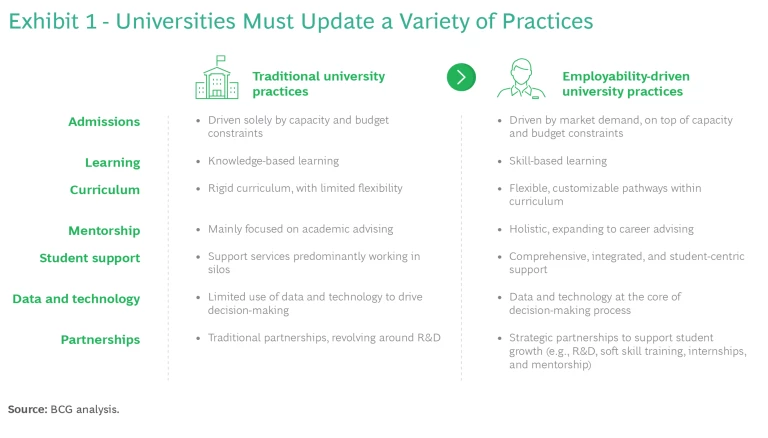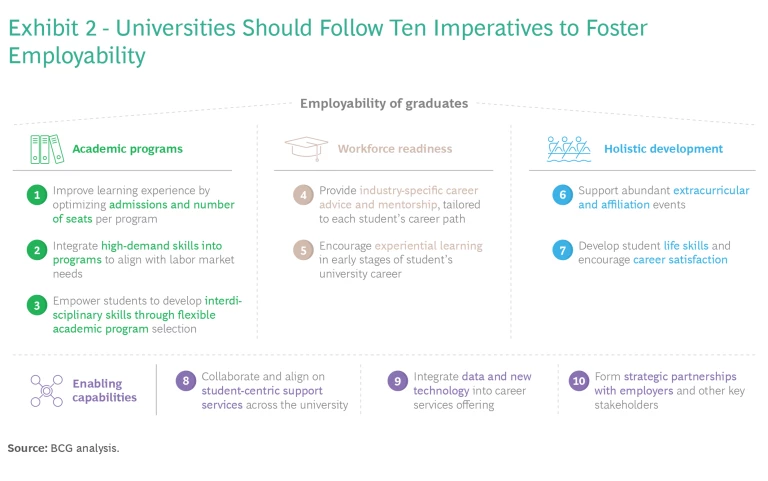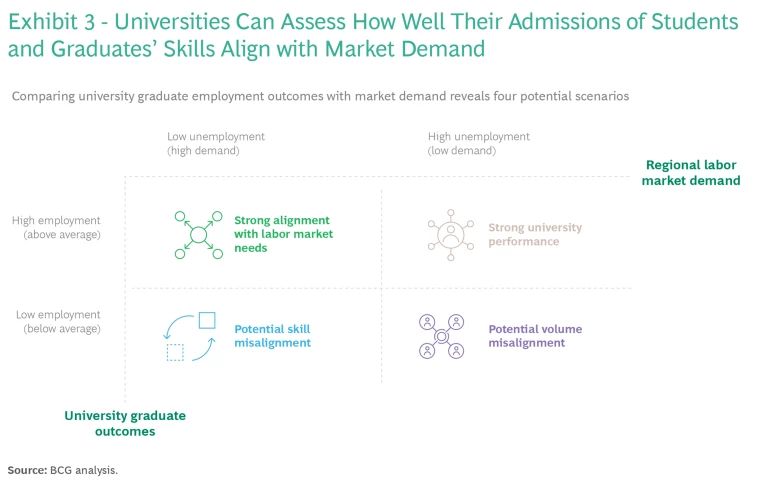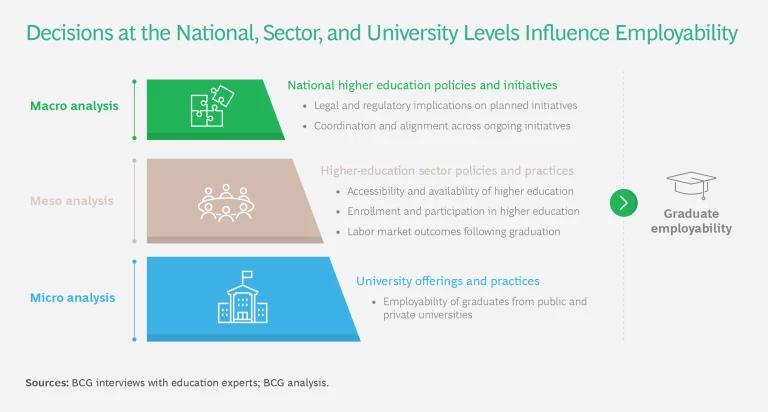To equip students with the skills required by the modern labor market, universities must shift their focus from enabling post-graduation employment to fostering lifelong employability. Employability encompasses the skills, competencies, and professional attributes that form an individual’s ability to obtain employment and achieve long-term success. Neglecting employability leaves students insufficiently prepared for the demands of the rapidly evolving labor market, hindering their competitiveness within an increasingly mobile and global talent pool.
The new focus on employability reflects the evolving mission of universities. (See “Universities’ Evolving Mission.”) By studying the best practices of 23 universities worldwide, BCG has identified ten imperatives, across four major categories, that universities should follow to maximize graduates’ employability.
UNIVERSITIES’ EVOLVING MISSION
Employability Is Essential for Closing the Skills Gap
To succeed in the modern labor market and adjust to the future of work, workers must develop a well-rounded and adaptable skill set, including:
- Digital Skills. Technology adoption will remain high and has the potential to accelerate in areas such as artificial intelligence, machine learning, cloud computing, and big data.
- Soft Skills. Today’s emphasis on soft skills will likely strengthen and expand to include self-management attributes such as active learning, resilience, stress tolerance, and flexibility.
- Meta Skills. Employers increasingly value cognitive skills such as problem-solving, critical thinking, and creativity in today’s complex and fast-paced work environments.
- Technical Skills. Workers need role-specific competencies to differentiate themselves in the highly competitive labor market.
For many people, developing this diverse skill set remains an elusive goal. Indeed, the accelerating labor-market transformation has led to a skills gap across industries worldwide. The World Economic Forum estimates that half of all employees will need reskilling by 2025, while closing the skills gap could add $11.5 trillion to global GDP by 2028.
To close the skills gap, national education systems must prioritize developing students’ capabilities for lifelong success in the labor market.
To close the skills gap, national education systems must prioritize developing students’ capabilities for lifelong success in the labor market (that is, employability), instead of the traditional emphasis on helping them get a job upon graduation (that is, employment).
When national education systems adopt an employability-focused outlook, all parties benefit:
- Current students profit, as employability initiatives reinforce the purpose of learning, better inform career exploration and outcomes, and promote access to a well-developed professional network.
- Graduates obtain a workplace-ready transferrable skill set, a head start at work through practical experience, and considerably improved lifetime job prospects.
- Institutions elevate their reputation among prospective staff and students, boost their brand perception among job recruiters, promote their long-term resilience, and achieve sustainable impact.
- Employers benefit from easier hiring, improvements in staff retention, reduced costs for skill building, and a higher return on training investments.
- Governments see reduced welfare spending due to lower unemployment, increased tax revenues resulting from higher wages, and a higher return on investments in education. Closing the skills gap also promotes a national economic advantage through a more productive and globally competitive workforce.
Universities Must Take the Lead in Fostering Employability
Each level of the higher-education landscape influences employability. (See “Decisions at All Levels Affect Employability.”)
DECISIONS AT ALL LEVELS AFFECT EMPLOYABILITY
- National (Macro) Level. Employability is affected by national policies and initiatives, such as the regulatory framework for higher education (including laws, guidelines, and quality assurance practices). It is also affected by the approaches used to coordinate national skilling initiatives and action plans.
- Sector (Meso) Level. The higher-education sector influences employability through practices related to access, availability, enrollment, and participation. Moreover, a sector-level analysis considers employment outcomes after graduation broadly, regardless of the university attended.
- University (Micro) Level. Universities’ offerings and initiatives directly affect graduates’ employability. Comprehensively understanding the effectiveness of these efforts requires qualitative and quantitative assessments of practices that foster employability and mapping these practices to graduate employment outcomes, across the institution and within specializations.
However, universities have a special obligation to foster employability for three main reasons: they train the workforce, receive a considerable societal investment, and promote social mobility.
- Training. Worldwide, a growing proportion of total job openings require higher education qualifications. In advanced economies, this is reaching an unprecedented level—for example, in 2022, the Australian government estimated that 90% of new job vacancies in the following five years would require a tertiary qualification.
3 3 “20,000 New University Places to Target Skill Shortage,” Ministers’ Media Centre, Department of Education, Australian Government, August 17, 2022, https://ministers.education.gov.au/chalmers/20000-new-university-places-target-skill-shortages. Moreover, higher education institutions produce the workforce for many occupations that are national priorities and face a talent shortage—particularly in science, technology, engineering, and mathematics (STEM) fields. - Social Investment. Higher education is a major investment for students and governments, with funding models in many nations reliant on graduates’ success in the labor market. According to World Bank data, national governments’ average spending on each student’s tertiary education represents a significant share of per capita GDP—for example, 38% in the UK, 26.3% in the European Union, and 19.4% in the US.
4 4 “Government Expenditure per Student, Tertiary (% of GDP per capita),” World Bank, https://data.worldbank.org/indicator/SE.XPD.TERT.PC.ZS. - Promoting Mobility. Universities are the main driver of social mobility for disadvantaged demographics via the labor market. For example, in the US, more than half of low-income students attending public or nonprofit universities moved up to one of the highest two income quintiles by their early 30s, according to a study by the American Enterprise Institute.
5 5 Jorge Klor de Alva and Cody Christensen, Universities and the Pursuit of the American Dream, American Enterprise Institute, July 2022, https://www.aei.org/higher-education-and-social-mobility/.
To address their obligation to focus on employability, universities need to update a variety of practices. (See Exhibit 1.)

The Employability Playbook for Universities
A BCG study of the employability initiatives of 23 universities worldwide reveals that these institutions excel across four major topics: academic programs, workforce readiness, holistic development, and enabling capabilities. These major offerings encompass ten imperatives that universities must act on to align the graduates’ skills with the demands of the modern labor market and thereby maximize employability. (See Exhibit 2.)

Academic Programs
Well-designed academic programs ensure that courses cover in-demand skills. There are three imperatives:
1. Improve the learning experience in academic programs by optimizing student admissions and the number of seats per program. Align student admissions in particular specialties with labor market needs and ensure that increasing the number of seats per program does not significantly affect class sizes or access to learning resources. For example, the University of Oxford, as part of its strategic plan, employs labor market forecasting to increase admissions in high-demand specializations. To ensure continued access to resources, Oxford is simultaneously building additional facilities.
2. Integrate high-demand skills into programs to align with labor market needs. It is critical to shift the focus from knowledge-based to skills-based learning. To inform this effort, engage with employers and industry groups to identify misalignments between skills developed in academic courses and those sought by the labor market. Collaborating with these partners to co-develop solutions, such as redesigned curricula, can help bridge existing skill gaps. For instance, the Royal Melbourne Institute of Technology (RMIT) forecast the growth of digital jobs in Australia. The university then formed strategic partnerships with major employers to establish pathways and programs aimed at reskilling current students so that they can access these job opportunities.
3. Empower students to develop interdisciplinary skills by offering flexible academic program selection. Allow students to select multiple majors or minors, pursue dual degrees, or add electives to the core curriculum. Another approach to promoting flexibility is modularizing courses—dividing the curriculum into small discrete units that are independent, nonsequential, and typically short in duration. Modularization offers students more flexibility, choice, and mobility and gives working professionals better lifelong learning opportunities. Brown University’s Open Curriculum, established in 1969, is a prime example of offering program flexibility. By customizing their course of study, students can create an interdisciplinary pathway or fully specialize in a specific field.
Workplace Readiness
Universities must assist students in translating learned skills into practical experiences relevant to their career path. There are two imperatives:
4. Provide industry-specific career advice and mentorship, tailored to each student’s career path. Create programs that pair new students with academic advisors and establish peer mentorship programs between senior and junior students. Additionally, involve the university’s alumni network and employer partnerships to give graduating students access to industry-specific career advice, job opportunities, and professional networks. For example, since its establishment in 2002, the Stanford Alumni Mentoring (SAM) program has been fostering connections between current students and more than 200,000 alumni. SAM connects students with alumni through an online platform that offers various engagement models, ranging from open forum-style discussions to structured one-on-one mentoring.
5. Encourage experiential learning in the early stages of a student’s university career. Incorporating experiential learning through practical courses, mandatory internships, job-shadowing, or simulated competitions inspires students to build a workplace-ready skillset and mindset. For example, at the University of Chicago, experiential learning is mandatory in some departments. This includes the renowned Harris School of Public Policy, where all students must complete both professional and research internships. Additionally, the university’s Summer Links program offers all students access to social impact internships during the summer break.
Holistic Development
Top universities encourage the development of a well-rounded skillset through out-of-classroom experiences. There are two imperatives:
6. Support abundant extracurricular and affiliation events. Offering extracurricular programs that complement academic learning encourages holistic growth, helps students connect with peers, and supports creative interests. For example, the University of California, Los Angeles (UCLA), boasts a well-established extracurricular program that encompasses both career and personal interests. UCLA has more than 1,000 student clubs, with three-quarters of enrolled students holding a club membership.
7. Develop student life skills and encourage career satisfaction. Create online tools and in-person programs to support students in improving life skills and navigating the transition to employment. Providing students with support channels, such as self-assessment toolkits and other resources, can help them identify personality traits and career aspirations, ensuring their post-graduation plans align with their life skills, values, and interests. For example, Wake Forest University’s Ready7 toolkit develops student life skills across seven broad themes, including personal branding, networking, and leadership.
Enhancing Capabilities
Leading institutions have created data-driven support services that leverage emerging technology and form strategic partnerships. There are three imperatives:
8. Collaborate and align on student-centric support services across the university. Establish an integrated, student-centric “one-stop shop” career service offering for personal, academic, and professional development. The availability of this service, along with access to university and professional stakeholders, helps to ensure that students get the right support when needed. For example, Johns Hopkins University launched its Student Services Excellence Initiative (SSEI) to modernize student services and cater to evolving student needs through a redesigned central student information system. The SSEI takes a student-centric view to provide a seamless experience across all touchpoints, such as recruitment, admissions, registration, and career services.
9. Integrate data and new technology into the career services offering. Incorporating predictive analysis tools and graduate employment data can help modernize career services. By developing an in-depth understanding of labor market trends and skills requirements, universities can update their academic programs accordingly. For instance, Harvard University and Northeastern University have partnered with Lightcast (formerly known as BurningGlass) to include labor market predictions in career services portals used by staff, students, and employers.
10. Form strategic partnerships with employers and other key stakeholders. Collaborate with employers, professional associations, and other universities to provide students with international experience or foster niche, high-demand skills. For example, the University of Cape Town has established international industry affiliations, such as with the CFA Institute (Chartered Financial Analyst Institute) and the CAIA Association (Chartered Alternative Investment Analyst Association). These partnerships enable the university to design academic curriculums that include in-demand skills defined by industry associations. They also create pathways for students to obtain internationally recognized accreditations (such as completing CFA/CAIA level 1 exam) while pursuing their degrees. The National University of Singapore (NUS) is well-known for its variety of high-quality programs offered alongside partner universities worldwide, including fixed-term international exchanges, joint degrees, concurrent degrees, and double degrees.
Stay ahead with BCG insights on education
Comparing Graduate Employment Outcomes with Labor Market Demand
Most universities will need new insights to optimize the admissions of students for a particular specialization and assess whether their courses meet the labor market skills demanded in that specialization, as described in imperatives #1 and #2.
Universities can use BCG’s Graduate Employment Outcomes Matrix to identify misalignments of graduate volume or skills with labor market needs.
To help universities gather these insights, BCG has developed the Graduate Employment Outcomes Matrix. (See Exhibit 3.) The matrix maps a university’s graduate outcomes in a specialization to regional labor market demand for graduates with the same specialization. This comparison enables universities to detect how well graduate volume or skills relating to a particular specialization align with market demand. Universities in a region can be plotted on the matrix to compare the employability of their graduates within a specialization. (In our analysis, regions are geographic subdivisions within a country, such as states or provinces.)

For each university and specialization, the analysis measures graduates’ outcomes as their employment rate 12 months after graduation, as per international standards. This type of employment rate is calculated periodically by universities through alumni surveys. If this employment rate is above the national average across all universities for the specialization, the university is deemed to have achieved high employment—otherwise, it is considered to have achieved low employment.
Regional labor market demand is measured as the regional unemployment rate for all workers (not just graduates) in the specialization. This unemployment rate can be typically obtained from the most recent national labor force survey. If the unemployment rate is greater than the regional average unemployment rate across all specializations, there is high unemployment (low demand) in the specialization—if not, there is low unemployment (high demand).
We use these outcomes to divide the matrix into four quadrants:
- Strong Alignment with Labor Market Needs. Graduates have strong employment outcomes in a specialization with high regional demand. This indicates no major employability concerns.
- Strong University Performance. Graduates have strong employment outcomes in a specialization despite low regional demand—an indication of strong university performance. The university is graduating the right number of students, or graduates are likely finding employment outside of the university’s region.
- Potential Skill Misalignment. Graduates have poor employment outcomes in a specialization despite high regional demand. This indicates that curriculums taught in the specialization are not tailored to labor market needs and do not effectively equip graduates with high-demand skills.
- Potential Volume Misalignment. Graduates have poor employment outcomes in a specialization with low regional demand. This indicates an oversupply of graduates in the specialization.
To address skill misalignment, universities can utilize skills forecasts (imperative #9) or involve partners in the review of the curriculum (imperative #10). This enables universities to collaborate with industry stakeholders to redesign the specialization’s curriculum to center on employable skills (imperative #2).
To address volume misalignment, universities can consider demand forecasts for particular jobs and specialties (imperative #9). They can then adjust the size of future cohorts more precisely (imperative #1).
Against the backdrop of global financial instability, universities must prioritize graduates’ employability as a primary strategic objective. BCG’s study of employability initiatives across 23 universities offers insights that institutions can apply in assessing and overhauling their current practices. Universities that act swiftly to capitalize on these findings can establish a positive feedback loop that enhances recruitment metrics, student satisfaction, and graduate outcomes year after year.









